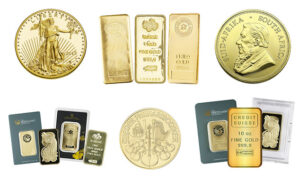If you feel a little daunted by the way gold is taxed, don’t fret. You’re not alone. Gold is a unique investment. Like any investment, it’s subject to some pretty complex tax rules. Add in the many ways you can own it and the complexity goes up. In this post, we’ll try to answer some of the common questions around taxes on gold & silver investments including:
- Can you buy & sell gold without paying taxes?
- How much gold can you buy without reporting it to the IRS?
- What are the IRS requirements for investing in gold & silver?
- Do you have to pay capital gains taxes on gold & silver investments?
- Does GoldSilver report my investments to the IRS?
- Do you have to pay taxes if you sell your gold jewelry?
| Quick pre-emptive strike from the lawyers: We’re not providing tax advice here, just certain general information. We aim to be accurate, but cannot guarantee that all information here is accurate or current or covers every individual case, and we do not assume any obligation to update any of the information contained here. Always consult a CPA and/or an attorney on tax issues. |
Here’s why it’s important to check with your certified public accountant about taxes on your gold investments…
• Rules can and do change. Getting it wrong can be very costly (not to mention the stress of dealing with the IRS).
• Your tax bracket and other personal considerations may make a difference.
• State capital gains tax rates vary.
• Those outside the US must adhere to their own country’s tax laws.
So, let us try to lay it out as clear as we can, by addressing the the two big topics: taxes and reporting…
Tax Treatment
There is a lot of conflicting and inaccurate tax information on the internet about taxes on gold and silver. And if you listen to the wrong sources, you can get hurt.
For example, we’ve found a few websites that claim the sale of American Silver Eagles is exempt from capital gains tax, based on an obscure law. While the law may read like you can sell gold and silver without paying taxes, that doesn’t mean it translates into practice with the IRS. In the case of the American Silver Eagle, it’s patently false.
Here’s what you need to know about taxes when you sell gold and silver…
Capital Gains Tax
The IRS considers precious metals a “collectible” for income tax purposes. Gains on collectibles held for less than one year are taxed as ordinary income – the same tax treatment as short-term capital gains. Gains on collectibles that are held for more than one year are treated as long-term and taxed at a maximum rate of 28%. So if you are in a federal tax bracket of 28% or greater, your net long-term gains from collectibles are taxed at 28%. If you are in a federal tax bracket lower than 28%, your net long-term gains from collectibles are taxed at your regular rate. The “collectibles” designation includes most forms of investment grade gold and silver, including:
• All denominations of precious metal bullion coins and numismatic coins, bars, wafers, etc.
• Precious metal “rounds” and commemorative coins
• Certificates such as those from the Perth Mint
• Certain Exchange Traded Funds (ETF’s). Precious metal ETF’s are generally divided into three categories: physical-backed ETF’s structured as grantor trusts, such as the popular GLD. These ETF’s are generally taxed as collectibles. Second are securities “tied to” precious metals, such as mining stocks, mutual funds and mining ETF’s and Exchange Traded Notes. These are generally taxed as securities. Third are closed-end funds, which are also trusts which generally are treated as collectibles.
Again, talk to your accountant and/or lawyer to maximize your tax position before investing.
Sell any form of precious metal at a profit and the profit will be taxed at a federal rate of 28% or less. Sell any form of precious metal at a loss and it will be used to offset any capital gains you have.
Privacy & Reporting
One of the many advantages of owning physical gold and silver is that they can be private and confidential. There aren’t too many investments you can say that about today.
So naturally, we get a lot of questions on this topic. Maybe you’ve wondered yourself…
• Are my purchases private?
• What do you report to the IRS when I sell back to you?
Private and Confidential? Yes, But…
First, when it comes to privacy and confidentiality, there are two issues to consider: buying and selling.
When you buy precious metals in the US…
The transaction is almost always private. There is no reporting requirement from a gold dealer to the IRS of what we sold to you, unless BOTH of the following conditions exist:
1. The transaction(s) exceed $10,000; AND
2. Actual cash (or money orders, bank or certified checks, etc.) is used to make the purchase(s).
In this highly unlikely event, a dealer would be required to file a Form 8300 with the IRS, as well as a Suspicious Activity Report (SAR) with the Financial Crimes Enforcement Network (part of the U.S. Department of the Treasury), due to regulations under the U.S. Patriot Act and Anti-Money Laundering (AML) rules. Your transaction is also confidential. The payment methods on our website are all encrypted. We also do not sell your email address or any information about you whatsoever to any agency, public or private. One other exception: when you sell gold or silver inside an IRA, this triggers a reporting requirement from the custodian on what is called Form 5498, which discloses all of your IRA investments each year. This is ostensibly so the IRS can track your ‘basis’ and properly check your calculations for taxes owed at the time of withdrawal.
When you sell precious metals…
Owner Reporting
When you sell precious metals overseas, the laws of the country in which you sell will apply to the sale. When you sell precious metals in the U.S., there are two different sets of reporting guidelines—one applies to the dealer through which you sell, and the other applies to you.
If you sell precious metals in the U.S. for a profit, you are required by U.S. law to report that profit on your income tax return, regardless of whether or not the dealer has any reporting obligation.
Dealer Reporting
Under certain circumstances, a dealer is required to file a form 1099-B with the IRS to report proceeds paid to a non-corporate seller of precious metals. This helps the IRS determine whether the sellers have properly reported this income on their tax returns. The IRS has specific rules that determine which sales of precious metals require the dealer to file this form.
The International Council for Tangible Assets (ICTA) has published guidelines for which precious metals transactions must be reported to the IRS based on negotiations it had with the IRS. While ICTA believes they reflect the spirit of their discussions with the IRS, they are only guidelines, not a ruling, and are thus open to interpretation by the IRS and subject to change without notice. As you likely know things aren’t always black and white with the IRS, which is why it’s important to check with your tax professional.
As of the date of this post, ICTA guidelines for reportable transactions were as follows:

What About Jewelry?
Gold and silver jewelry, like bullion, is also considered a collectible. So if you sell your bullion jewelry for a profit, it is subject to the same maximum 28% capital gains rate for precious metals and must be reported on your income tax return. Current law does not require that dealers report jewelry sales, even when dealing with 22K or 24K bullion-grade pieces, or in quantities above the 25 ounce limits applied to bars and many coins. That’s another reason why investment grade bullion jewelry is attractive: it’s a real asset that’s both portable, and discreet. It can even reduce the hassle when crossing borders. Gold and silver bullion can attract unwanted attention or require special declarations for monetary instruments—but a gold necklace is, well, just another gold necklace.
The Best Advice…
As most good accountants will tell you, investment decisions should never be made based solely on tax considerations. Taxes are an expense, not a cost. You only pay them when you first make a profit. More importantly, we prefer to own gold and silver because they are one of the very few assets that have stood the test of time for generations, through one crisis after another. It is one of the most effective hedges we know against political and monetary risks, from basic inflation to severe market crashes. Providing your portfolio with that protection is far more important than what your tax liability might be.








